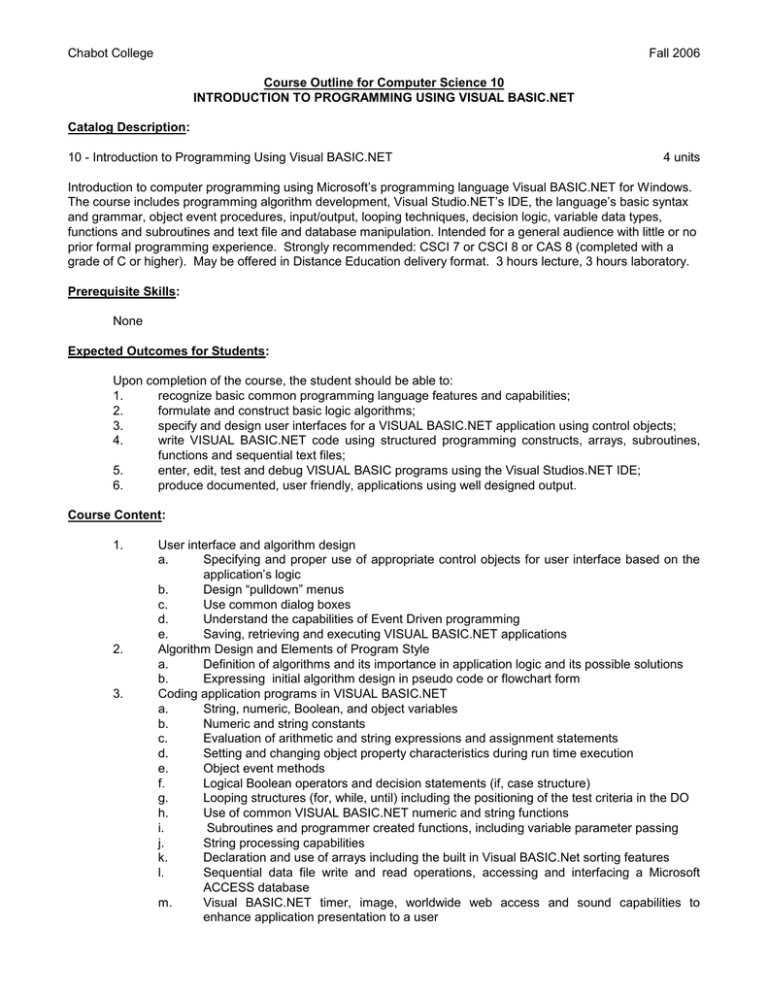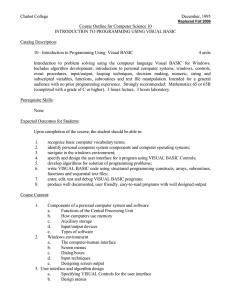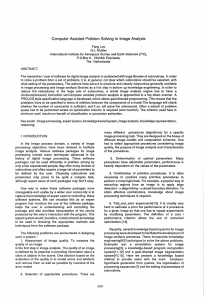Chabot College Fall 2006 Course Outline for Computer Science 10
advertisement

Chabot College Fall 2006 Course Outline for Computer Science 10 INTRODUCTION TO PROGRAMMING USING VISUAL BASIC.NET Catalog Description: 10 - Introduction to Programming Using Visual BASIC.NET 4 units Introduction to computer programming using Microsoft’s programming language Visual BASIC.NET for Windows. The course includes programming algorithm development, Visual Studio.NET’s IDE, the language’s basic syntax and grammar, object event procedures, input/output, looping techniques, decision logic, variable data types, functions and subroutines and text file and database manipulation. Intended for a general audience with little or no prior formal programming experience. Strongly recommended: CSCI 7 or CSCI 8 or CAS 8 (completed with a grade of C or higher). May be offered in Distance Education delivery format. 3 hours lecture, 3 hours laboratory. Prerequisite Skills: None Expected Outcomes for Students: Upon completion of the course, the student should be able to: 1. recognize basic common programming language features and capabilities; 2. formulate and construct basic logic algorithms; 3. specify and design user interfaces for a VISUAL BASIC.NET application using control objects; 4. write VISUAL BASIC.NET code using structured programming constructs, arrays, subroutines, functions and sequential text files; 5. enter, edit, test and debug VISUAL BASIC programs using the Visual Studios.NET IDE; 6. produce documented, user friendly, applications using well designed output. Course Content: 1. 2. 3. User interface and algorithm design a. Specifying and proper use of appropriate control objects for user interface based on the application’s logic b. Design “pulldown” menus c. Use common dialog boxes d. Understand the capabilities of Event Driven programming e. Saving, retrieving and executing VISUAL BASIC.NET applications Algorithm Design and Elements of Program Style a. Definition of algorithms and its importance in application logic and its possible solutions b. Expressing initial algorithm design in pseudo code or flowchart form Coding application programs in VISUAL BASIC.NET a. String, numeric, Boolean, and object variables b. Numeric and string constants c. Evaluation of arithmetic and string expressions and assignment statements d. Setting and changing object property characteristics during run time execution e. Object event methods f. Logical Boolean operators and decision statements (if, case structure) g. Looping structures (for, while, until) including the positioning of the test criteria in the DO h. Use of common VISUAL BASIC.NET numeric and string functions i. Subroutines and programmer created functions, including variable parameter passing j. String processing capabilities k. Declaration and use of arrays including the built in Visual BASIC.Net sorting features l. Sequential data file write and read operations, accessing and interfacing a Microsoft ACCESS database m. Visual BASIC.NET timer, image, worldwide web access and sound capabilities to enhance application presentation to a user Chabot College Course Outline for Computer Science 10, Page 2 Fall 2006 4. Structure and documentation of programs a. Using subroutines to modularize application logic b. Improve maintenance efficiency by including comment remarks, indentation, and spacing and well chosen variable naming conventions Methods of Presentation: 1. 2. 3. Lecture, class discussion and demonstrations Student use of an appropriate computer laboratory with Visual Studios.NET Blackboard application example downloads Assignments and Methods of Evaluating Student Progress: 1. Typical Assignments a. b. c. d. 2. Code a basic input and output application that allows a user to enter two numerical values which will calculate their sum, product, dividend, difference and power (add, subtract, multiply, divide, raise to a power) and display it on a form Code an application that uses a For…Next, While or Until loop that will allow a user to enter a Loan amount, interest rate and loan term which will calculate the monthly payment, interest portion of that payment, principle portion of that payment, balance for each month of that loan term. Using a random number generator, code a program that will simulate the Lotto. The logic will allow a user to enter 6 numbers (i.e. 1 to 50) , randomly select 6 numbers to simulate the Lotto draws, compare the results and determine if the player “wins” (3 or more matches out of 6 “wins” varying prize money) Code a program that allows a user to select a product at a set price and enter their name. The program logic will do an automatic calculation and then write that order to a data file on the first form. The logic will allow that user to shift to a second form in the application and “see” all orders from that data file displayed. Methods of Evaluating Student Progress: a. b. c. Exams which, according to instructor preference, may include quizzes, midterms and a required final examination. Each course instructor may choose his/her examination modality but is expected to test during the term. All instructors are expected to write tests which relate to the lecture/discussion/assignments/textbook being presented in the course. Students will be asked to write and implement assigned programs and other assignments which utilize topics included in the course of study. Grading based upon a combination of exam scores and assignments. Textbook(s) (Typical): Microsoft Visual Basic.NET Reloaded, Diane Zak, Thompson, 2004 Programming with Visual Basic.NET, 2nd Edition, Diane Zak, Thompson, 2005 Special Student Materials: Removable storage media such as USB Flash drives or floppy diskettes Microsoft Visual Studios.NET for optional home installation DChun.al revised 10/18/05




